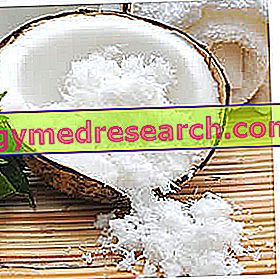Generality
Coconut flour is the powder (more or less fine, but generally very coarse compared to the cereal flours) obtained by grinding the dried coconut pulp.

Nutritional Features
| Composition for: 100g of Coconut, Dried - Reference values of the INRAN Food Composition Tables | |||||||||||||||||||||||||||||||||||||||||||||||||||||||||||||||||||||||||||||||||||||||||||||||||||||||||||||||||||||||||||||||||||||||||||||||||
 | |||||||||||||||||||||||||||||||||||||||||||||||||||||||||||||||||||||||||||||||||||||||||||||||||||||||||||||||||||||||||||||||||||||||||||||||||
Nutritional values (per 100 g of edible portion)
| |||||||||||||||||||||||||||||||||||||||||||||||||||||||||||||||||||||||||||||||||||||||||||||||||||||||||||||||||||||||||||||||||||||||||||||||||
Coconut flour is a food rich in lipids and poor in water. The energy supply is very high, intermediate between a condiment oil and a refined cereal flour.
The ratio of fatty acids is in favor of the saturated, a negative aspect for the metabolism of cholesterol. On the other hand, coconut fatty acids make use of a very rare peculiarity; a good slice of the polymers has a medium chain, a characteristic that (following the digestion of triglycerides) makes them quickly absorbable and placed directly into the bloodstream (contrary to the long chains that become part of the chylomicrons poured into the lymphatic stream). Another food that has similar properties is human breast milk.
Proteins and carbohydrates are present in small quantities, while the fiber is decidedly abundant.
From the vitamin point of view, coconut flour does not show concentrations worthy of note; on the contrary, as far as mineral salts are concerned, good amounts of potassium and iron are inferred.
Culinary aspects
Coconut flour is commercially available in two different forms: the coco rapè (grated), used above all for decorations and coverings, and fine flour, instead more suitable for the formulation of the dough.
Coconut flour is a raw material widely used in gastronomy. It is an ingredient that lends itself above all to the composition of desserts, both spoon desserts and dry pastries. Some examples are: Coconut and Liquorice Dolcetti, Coconut Butter-Free Cake, and Ricotta Cheesecake with Coconut and Cherries.
There are also alternative preparations such as coconut milk (of which you can consult the video recipe by clicking here) and coconut liqueurs.
Homemade Bounty - Vegan
X Problems with video playback? Reload from YouTube Go to Video Page Go to Video Recipes Section Watch the video on youtube



